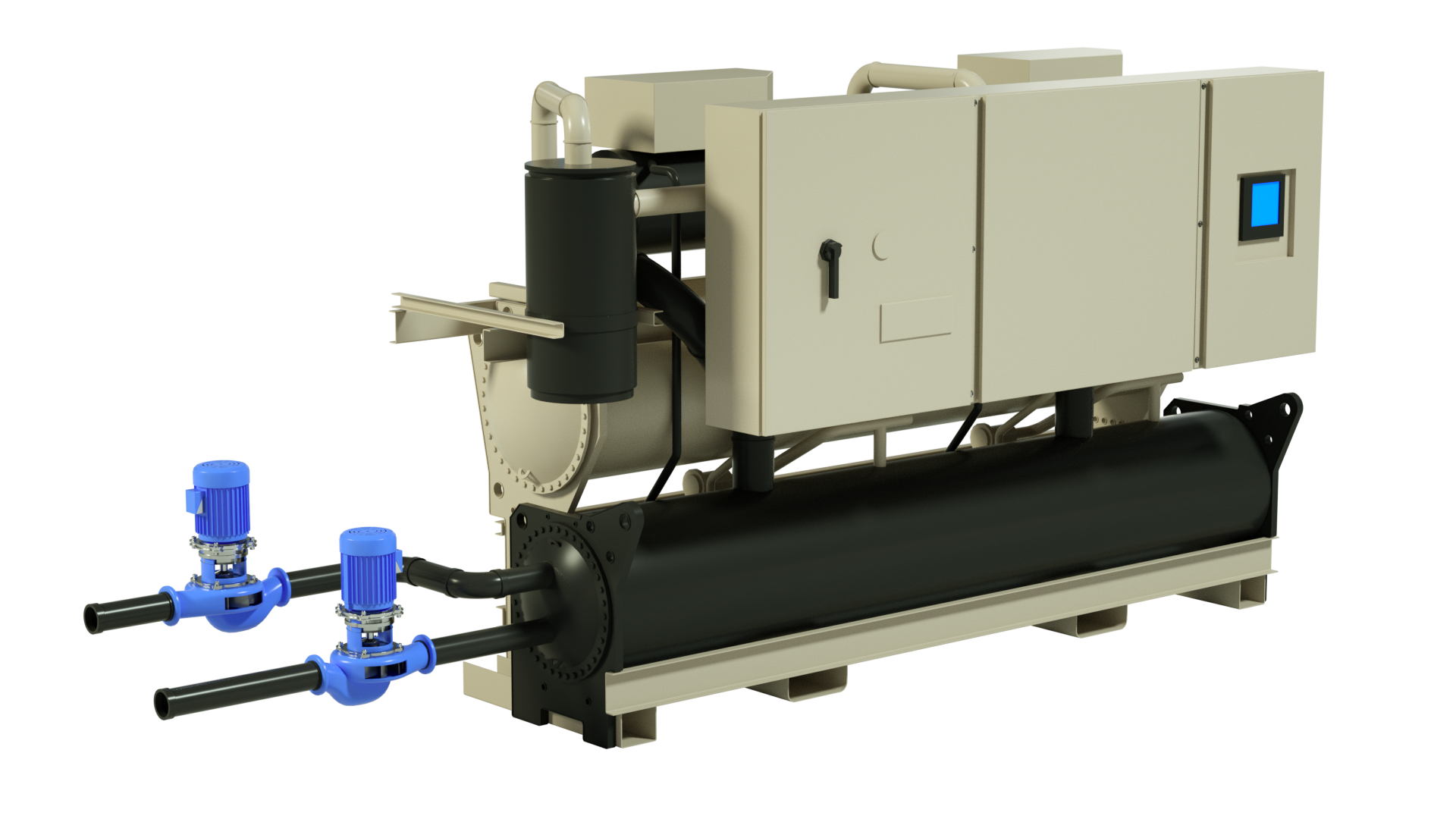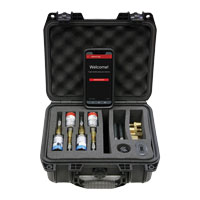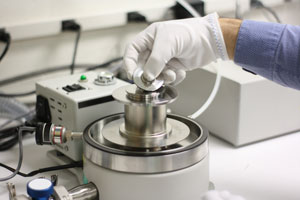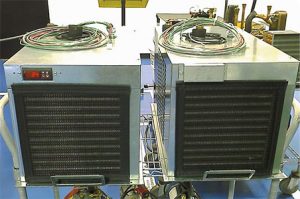 Water chillers are nothing new, with nearly an estimated 100,000 units operating in North America alone. Chillers are the cooling machines of choice to condition industrial, commercial, and institutional facilities. They are used to lower the temperatures of all kinds of equipment and processes such as: robotic machinery; semiconductors; injection and blow molding machines; welding equipment; die-casting and machine tooling; paper and cement processing; power supplies; power generation stations; compressed air and gas cooling systems; medical imaging machines; chemical, drug, food and beverage production; even simply to cool potable water to desirable levels. Whether for office comfort, keeping data server centers from overheating, or specialized industrial processes, water temperature control plays a vital role in many of the behind-the-scenes activities that affect our everyday lives. Continue reading “Proving Flow Through Chillers”
Water chillers are nothing new, with nearly an estimated 100,000 units operating in North America alone. Chillers are the cooling machines of choice to condition industrial, commercial, and institutional facilities. They are used to lower the temperatures of all kinds of equipment and processes such as: robotic machinery; semiconductors; injection and blow molding machines; welding equipment; die-casting and machine tooling; paper and cement processing; power supplies; power generation stations; compressed air and gas cooling systems; medical imaging machines; chemical, drug, food and beverage production; even simply to cool potable water to desirable levels. Whether for office comfort, keeping data server centers from overheating, or specialized industrial processes, water temperature control plays a vital role in many of the behind-the-scenes activities that affect our everyday lives. Continue reading “Proving Flow Through Chillers”
[New Product Highlight] StabiliSENSE™ Critical Room Pressure Monitor | Series RPMC
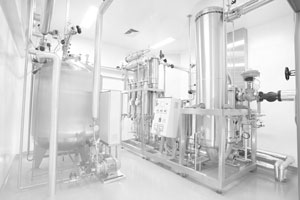 The Dwyer team recently released the StabiliSENSE™ critical room pressure monitor, Series RPMC. This series is ideal for critical low differential room pressure applications, such as: clean manufacturing areas, semiconductor manufacturing, pharmaceutical, clean rooms, research labs, and vivariums. Continue reading “[New Product Highlight] StabiliSENSE™ Critical Room Pressure Monitor | Series RPMC”
The Dwyer team recently released the StabiliSENSE™ critical room pressure monitor, Series RPMC. This series is ideal for critical low differential room pressure applications, such as: clean manufacturing areas, semiconductor manufacturing, pharmaceutical, clean rooms, research labs, and vivariums. Continue reading “[New Product Highlight] StabiliSENSE™ Critical Room Pressure Monitor | Series RPMC”
Our Updated Mobile App Makes Hydronic Balancing Easier Than Ever!
Dwyer’s Hydronic Application has added many updates since its first launch in August 2018, but today we are proud to present version 2.0.1 of the app!

We’ve taken technician feedback into consideration to improve the overall user experience in the app, ensuring that balancing a hydronic system is now easier than ever. Continue reading “Our Updated Mobile App Makes Hydronic Balancing Easier Than Ever!”
ISO/IEC 17025 Calibration in Food and Agriculture
World Accreditation Day
Yesterday (June 9, 2020) marked this year’s World Accreditation Day, which is a global initiative established by the International Laboratory Accreditation Cooperation (ILAC) and the International Accreditation Forum (IAF) to promote the value of accreditation.
 This year’s focus was on how accreditation improves food safety, supporting the confidence of consumers, suppliers, purchasers, regulators and specifiers in the quality and safety of food [1]. When it comes to ensuring food safety, consumers and suppliers rely on their equipment and calibration providers to comply with the appropriate international standards, such as ISO/IEC 17025:2017.
This year’s focus was on how accreditation improves food safety, supporting the confidence of consumers, suppliers, purchasers, regulators and specifiers in the quality and safety of food [1]. When it comes to ensuring food safety, consumers and suppliers rely on their equipment and calibration providers to comply with the appropriate international standards, such as ISO/IEC 17025:2017.
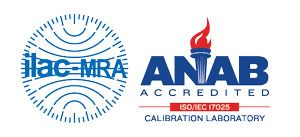 Attaining accreditation status to ISO/IEC 17025:2017 is a rigorous process that ensures that the technical competence of personnel, the ethics of personnel, and the reliability of the organization itself are at a level that can be recognized on an international scale. The Dwyer Instruments, Inc. Engineering Laboratory is proud to be able to provide ISO/IEC 17025:2017, ANSI/NCSL Z540-1-1994 and ANSI/NCSL Z540.3 Section 5.3 accredited calibrations on pressure products that are used in these critical food safety environments. Continue reading “ISO/IEC 17025 Calibration in Food and Agriculture”
Attaining accreditation status to ISO/IEC 17025:2017 is a rigorous process that ensures that the technical competence of personnel, the ethics of personnel, and the reliability of the organization itself are at a level that can be recognized on an international scale. The Dwyer Instruments, Inc. Engineering Laboratory is proud to be able to provide ISO/IEC 17025:2017, ANSI/NCSL Z540-1-1994 and ANSI/NCSL Z540.3 Section 5.3 accredited calibrations on pressure products that are used in these critical food safety environments. Continue reading “ISO/IEC 17025 Calibration in Food and Agriculture”
Certificates of Calibration Explained
 Dwyer Instruments, Inc. offers a variety of calibration services for new or previously purchased products. In 2019, the Dwyer Instruments, Inc. – Engineering Laboratory, located in Michigan City, IN, gained accreditation to ISO/IEC 17025:2017 through the ANSI National Accreditation Board. The Dwyer lab now offers two different types of calibration certificates for our products: a certificate of NIST calibration and an ISO/IEC 17025:2017 accredited certificate of calibration. Now that accredited calibration services are available for select Dwyer products, it is important to know the differences between these two different calibration certificates. Knowing these differences will allow you to understand which calibration certificate will best suit your needs. Continue reading “Certificates of Calibration Explained”
Dwyer Instruments, Inc. offers a variety of calibration services for new or previously purchased products. In 2019, the Dwyer Instruments, Inc. – Engineering Laboratory, located in Michigan City, IN, gained accreditation to ISO/IEC 17025:2017 through the ANSI National Accreditation Board. The Dwyer lab now offers two different types of calibration certificates for our products: a certificate of NIST calibration and an ISO/IEC 17025:2017 accredited certificate of calibration. Now that accredited calibration services are available for select Dwyer products, it is important to know the differences between these two different calibration certificates. Knowing these differences will allow you to understand which calibration certificate will best suit your needs. Continue reading “Certificates of Calibration Explained”

